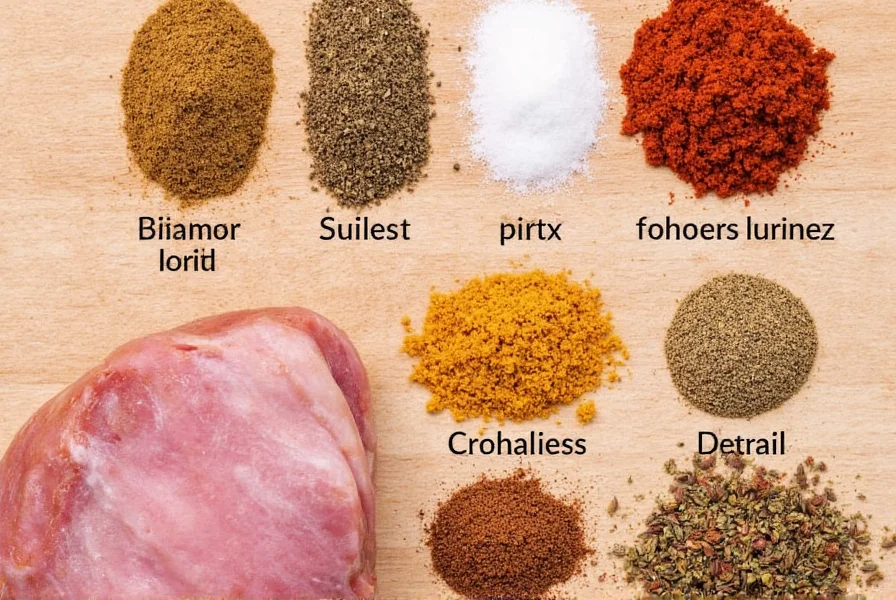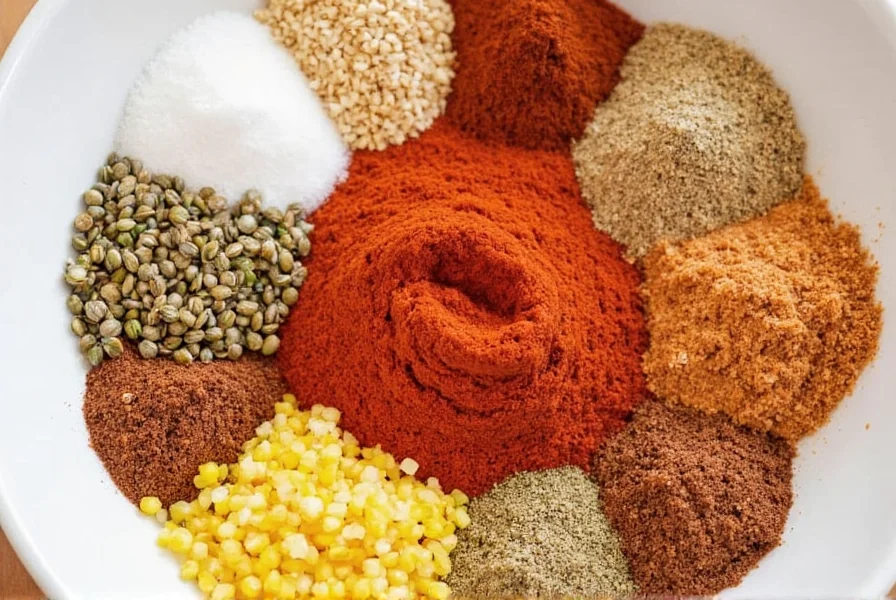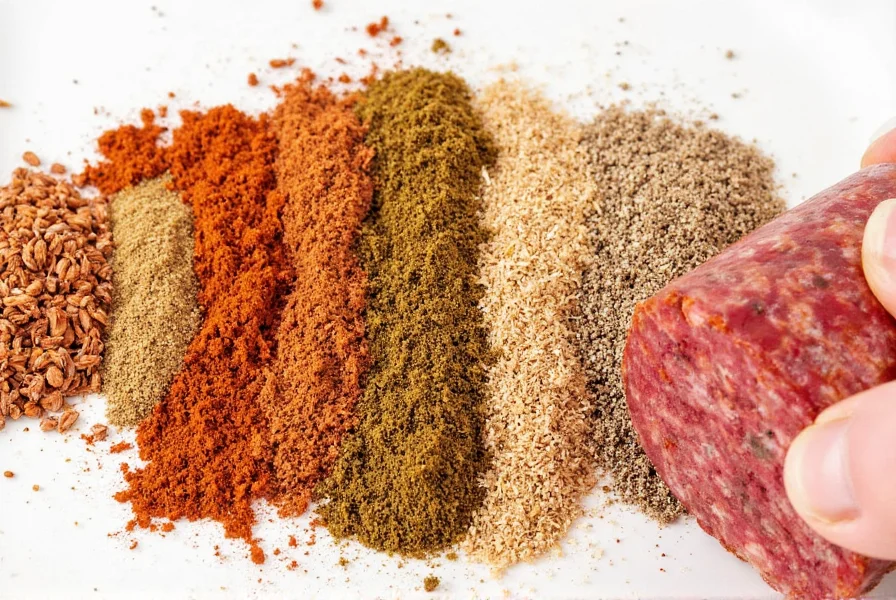Discover the top 7 spices for ground pork sausage with exact measurements, blending techniques, and storage tips to create restaurant-quality sausages at home. These essential spices transform basic pork into flavorful masterpieces for any meal.
Top 7 Spices for Ground Pork Sausage
For every pound (450g) of ground pork, use these precise spice measurements to achieve balanced flavor:
| Spice | Amount per Pound | Key Flavor Role | Best Uses |
|---|---|---|---|
| Fennel Seed | 1.5 tsp | Classic Italian sweetness with licorice notes | Italian sausage, breakfast links |
| Black Pepper | 1 tsp | Heat and complexity to enhance pork fat | All sausage styles |
| Garlic Powder | 1.5 tsp | Consistent umami without moisture issues | Bacon-style, smoked sausages |
| Thyme | 1 tsp | Earthy floral notes balancing fattiness | Mediterranean blends, stews |
| Nutmeg | 1/4 tsp | Warm sweetness (use sparingly) | British sausages, breakfast blends |
| Paprika | 1 tsp | Color and mild smokiness | Chorizo, smoked sausages |
| Red Pepper Flakes | 1/2 tsp | Controlled heat and texture | Spicy Italian, Mexican chorizo |

How Each Spice Shapes the Flavor
Fennel Seed
Fennel seed is the cornerstone of Italian sausage. When toasted, its oils release sweet anise notes that complement pork's richness. Critical for authentic Italian sausages but optional for other styles.
Black Pepper
Use freshly cracked pepper for maximum flavor impact. Its sharp heat cuts through pork fat, creating balance. Always grind whole peppercorns just before mixing.
Garlic Powder
Superior to fresh garlic for sausages due to consistent flavor and no moisture issues. Creates deep umami without raw garlic bite. Ideal for smoked and breakfast sausages.
Thyme
Delivers subtle floral notes that enhance pork's natural sweetness. Works exceptionally well with apples or root vegetables in sausage recipes. Use dried for better distribution.
Nutmeg
A tiny pinch (1/4 tsp per pound) adds warm complexity. Overuse creates medicinal bitterness. Essential for British-style sausages and breakfast blends.
Paprika
Smoked paprika creates authentic barbecue flavor. Regular paprika adds vibrant color without heat. Always use high-quality paprika to avoid bitterness.
Red Pepper Flakes
Adjust quantity based on desired heat level. Crushed flakes provide texture and controlled spice. For mild heat, reduce to 1/4 tsp per pound.
Pro Tips for Blending the Perfect Sausage Mix
- Always mix dry spices first: Combine all spices in a bowl before adding to meat for even distribution.
- Use ice water: Add 1-2 tbsp ice water per pound to help bind ingredients and keep meat tender.
- Rest time is critical: Refrigerate seasoned meat for 12-24 hours before cooking to allow flavors to fully develop.
- Test before committing: Cook a small patty to adjust seasoning before processing the entire batch.
| Style | Key Spices | Heat Level | Best Pairings |
|---|---|---|---|
| Italian Sausage | Fennel (1.5 tsp), Garlic (1.5 tsp), Black Pepper (1 tsp), Red Pepper (1/2 tsp) | Medium | Tomato sauce, pasta |
| British Breakfast | Nutmeg (1/4 tsp), Thyme (1 tsp), Sage (1 tsp), Black Pepper (1 tsp) | Mild | Eggs, baked beans |
| Chorizo | Smoked Paprika (1 tsp), Garlic (1.5 tsp), Cumin (1/2 tsp), Red Pepper (1 tsp) | Medium-High | Beans, rice, eggs |
Buying Guide: Choosing Quality Spices
For optimal flavor, follow these spice selection guidelines:
- Whole vs. Ground: Buy whole fennel seeds and peppercorns; grind fresh for maximum aroma. Other spices can be pre-ground if from reputable brands.
- Storage: Keep in airtight containers away from light and heat. Replace every 6 months for peak freshness.
- Brand Recommendations:
- Penzeys Spices: Best for bulk, high-quality spices (especially fennel and smoked paprika)
- Spice Islands: Reliable for everyday use with consistent flavor
- The Spice Garden: Ideal for organic, non-GMO options

Frequently Asked Questions
What is the ideal spice-to-meat ratio for pork sausage?
The standard ratio is 2-3% spice by weight of the meat. For every pound (450g) of ground pork, use 1-1.5 tablespoons total spice mix. Always measure by weight for accuracy.
Can I substitute fresh herbs for dried spices in sausage making?
Yes, but use triple the amount of fresh herbs (since dried are concentrated). For example, 1 tsp dried thyme = 1 tbsp fresh. Chop very finely and add at the end of mixing to prevent bitterness.
How long can I store seasoned ground pork before making sausages?
For best results, use within 24 hours. The salt in spices begins curing the meat, changing texture over time. Properly wrapped and refrigerated, maximum 48 hours, but flavor peaks at 12-24 hours.
What's the most common spice mistake when making pork sausage?
Over-salting is the #1 error. Many commercial spice blends already contain salt. Always taste a cooked patty before processing the full batch. Another mistake is using too much nutmeg or cayenne, which easily overpower the blend.
Can I make sausage without fennel if I dislike licorice flavors?
Absolutely. Replace fennel with coriander seeds (1 tsp) for similar floral notes without licorice. For breakfast sausage, focus on sage (1 tsp), nutmeg (1/4 tsp), and black pepper (1 tsp).
How should I store homemade sausage spice blends?
Store in airtight containers away from light and heat. Most blends maintain peak flavor for 3-6 months. For longer storage, freeze in labeled containers where they'll last up to a year. Always include the blend date.
Conclusion
Mastering spice combinations for ground pork sausage transforms ordinary meals into extraordinary experiences. With precise measurements, proper blending techniques, and quality ingredients, you can create restaurant-quality sausages at home. Remember: start with the right spice ratios, test before committing, and always respect the resting period for maximum flavor development. Happy cooking!












 浙公网安备
33010002000092号
浙公网安备
33010002000092号 浙B2-20120091-4
浙B2-20120091-4